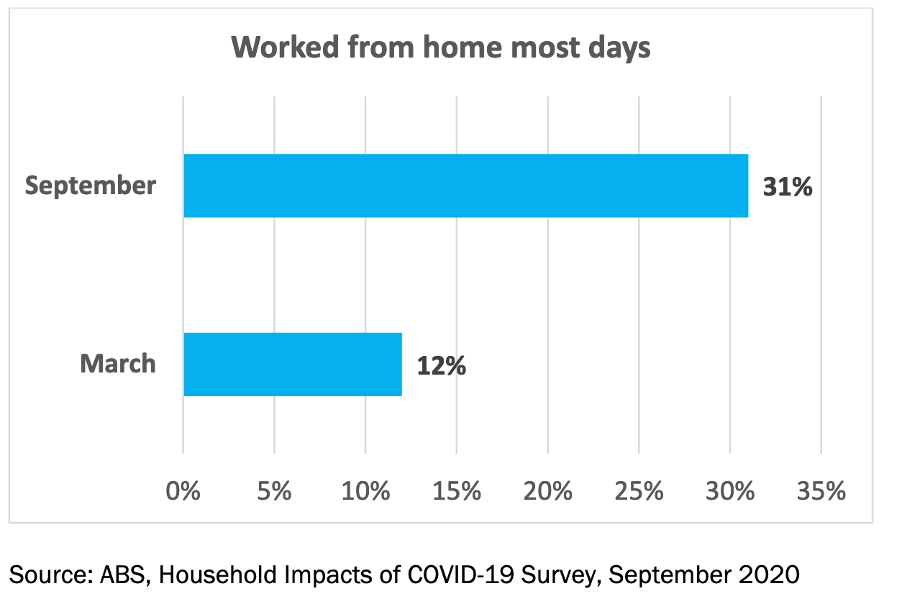
11 June 2021
The number of people working from home Data from the ABS released on the 13th October 2020 shows the number of people working from home during the pandemic had increased significantly.
The survey asked people to reflect on how often they worked from home prior to COVID-19 restrictions, and their work from home frequency over September.
Australians with a job reported that prior to the COVID-19 restrictions in March 2020:
In September we can see the frequency of working from home had increased significantly, Australians currently with a job reported:
Figure One: There has been a significant increase in the frequency of those working at home most days.

Positive Affects
The positive effects of working from homeWorkers report a reduction in commuting time, greater working time autonomy leading to more flexibility, a better overall work–life balance (for some) and higher productivity to be among the positive effects of working from home. These benefits flow directly to employers who benefit from increased worker motivation and reduced turnover as well as enhanced productivity and efficiency.
Employers also benefit from a reduction in the need for office space and associated costs.There has been an astonishing acceleration in the use of technology.
Research from AlphaBeta found that Australian companies have on average increased their adoption of some digital technology during the COVID 19 period of the past seven months by as much as the previous 10 years3.According to AlphaBeta, nearly 9 in 10 Australian firms adopted new technologies to improve their business continuity during COVID; with 13% of businesses saying technology tools were essential to continued operations.
The adoption of technology tools supported 3.2 million workers who would otherwise have been unable to perform their roles in compliance with social distancing rules. 1.6 million of these workers may have been completely unable to work without the technology tools5.A substantial increase in the uptake of technology and a reduction in commuting times has the potential to improve national levels of productivity.
Will working from home improve productivity?
The economist John Quiggin believes we might have stumbled upon a massive opportunity for a microeconomic reform, yielding benefits far greater than those of the hard-fought changes of the late 20th century.
He notes that the average worker spends an hour on commuting every workday:
‘If working from home eliminated an hour of commuting, without changing time spent on work or reducing production, the result would be equivalent to a 13 per cent increase in productivity (assuming a 38-hour working work). If half the workforce achieved such a gain, it would be equivalent to a 6.5 per cent increase in productivity for the labour force as a whole.’
Quiggin notes that these productivity improvements would be far greater than the radical microeconomic reforms of the 1990s, including privatisation, deregulation, and national competition policy.
The ACTU Working from Home Survey suggests that improvements in productivity have already materialised with almost half (47.7%) of home workers reporting they were more productive.
The disadvantages of working from home
The disadvantages of working from home include the tendency to lead to longer working hours, to create an overlap between paid work and personal life (work–home collision), and to result in work intensification.
3 Strategies to Reduce Telecom Cost